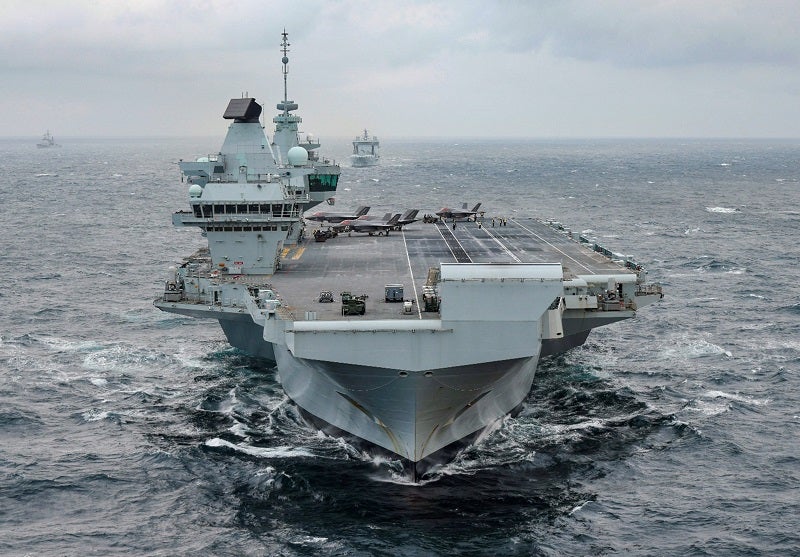
UK defence priorities are increasingly determined by the jobs and economic conditions that surround certain programmes.
Recent defence activity over the last month, since the government’s Budget statement was released at the end of October, the Ministry of Defence (MoD) has begun to implement cost-cutting measures which have affected certain projects.
As part of these measures, the Secretary of State for Defence John Healey, in his first session in front of the newly formed Defence Select Committee on 21 November, offered an ambiguous assessment of a major flagship programme that until now seemed beyond reproach.
Both of the Royal Navy’s two Queen Elizabeth-class aircraft carriers “are under scrutiny but not in jeopardy,” he said.
“The decisions that we will have to take are those that will we will take – but we’ll take it in light of the reviewers’ analysis when they come to report.”
The status of the two carriers, which entered service in 2017 and 2019 respectively, are dependent on the findings outlined in the Strategic Defence Review (SDR). This hotly anticipated examination of the Armed Forces’ capabilities and global strategy will be released in the spring of 2025.
How well do you really know your competitors?
Access the most comprehensive Company Profiles on the market, powered by GlobalData. Save hours of research. Gain competitive edge.

Thank you!
Your download email will arrive shortly
Not ready to buy yet? Download a free sample
We are confident about the unique quality of our Company Profiles. However, we want you to make the most beneficial decision for your business, so we offer a free sample that you can download by submitting the below form
By GlobalDataUnlike the dubious position of the British carriers, the Global Combat Air Programme (GCAP) to build a sixth generation crewed fighter jet is treated as an indispensable endeavour by MoD officials, more as a source of economic prosperity these days than for its next-generation capability.
In a parliamentary written response on 25 November, the Minister for Defence Procurement and Industry, Maria Eagle noted that the government want to align the imperatives of national security with a high-growth economy:
“The combat air sector… provides highly skilled jobs across the UK and the [future] Defence Industrial Strategy will consider how we grow and retain the skills needed, working closely with partners across government, industry and skills bodies to ensure we retain and attract a skilled workforce across the sector.”
Slimming down defence
On 20 November, Healey addressed Parliament to lay out plans to cut programmes and platforms. This includes an end to the British Army’s close-to-obsolete Watchkeeper tactical uncrewed aerial vehicle programme, but more significantly, and perhaps unnecessarily, a Type 23 frigate and two Albion-class amphibious assault ships.
While the decision will save up to £500m ($629.2m) over the next five years, the move will reduce mass – a major consideration when we consider the attritional rate of platforms in Ukraine as Britain inexorably approaches conflict in Europe against Russia this decade.
“These are common-sense decisions,” Healey added without offering a replacement for these new gaps in the UK’s military. “They are decisions which have been backed by the Chiefs and have been taken into consultation with SDR reviewers.
“Our soldiers, our sailors, aviators have been stuck with old, outdated equipment because [previous Conservative] ministers wouldn’t make the difficult decommissioning decisions.”
This activity indicates that enduring programmes are only here to stay in their full-fledged capability so long as they deliver economically and without any operational issues. This is worrying given the enduring trouble with the carriers.

Carriers could be mothballed
The relative inactivity of the service’s two aircraft carriers, combined with each suffering mechanical problems that have required repairs, could see each vessel taking turns in being placed in ‘extended readiness’, effectively mothballed by another name.
Lately, the Royal Navy response to Houthi disruption in the Red Sea centred on the use of its Type 45 air defence destroyers, which operated well, claiming dozens of kills of Houthi drones and anti-ship missiles fired at civilian ships. The absence of a Queen Elizabeth-class carrier was notable, given their relative proximity to the region and theoretical ability to embark an air defence group.
Their absence resonated in another written response from a senior MoD official on 22 November. The official noted the “credible” posture of Type 23 and Type 45 combatants as part of the UK’s carrier strike capability, without any reference to the carrier centrepiece.
Under the former Conservative government, Britain arranged a Carrier Strike Group in 2025 to which the incumbent administration is also committed. This will be led by HMS Prince of Wales, the second in the class, which will deploy to the Indo-Pacific where the fleet will interoperate with allies and partners in the region. Certain naval assets in the Royal Norwegian Navy will accompany the British expedition.
GCAP: a source of economic growth
Earlier this month, the UK government cited a forecast that suggested the Tempest programme – the UK name for GCAP – is expected to contribute £26.2bn to the British economy from 2021 to 2050. In addition, it would support on average 21,000 jobs per annum from development to operational service.
At this stage, however, the unit price of each aircraft and the size of the UK order are unknown, meaning the total cost of the programme remains unquantified.

Moreover, Justin Bronk, airpower specialist, RUSI, has argued that Tempest is competing for funding with the requirement to regenerate frontline Royal Air Force combat capability to deter Russia and meet Nato commitments this decade. This reality, he says, means that the current funding falls short of the required level of investment.
To give some sense of the complexity and scale of building a sixth generation aircraft, we need only look to the US Air Force, which has lately taken a step back from their own Next Generation Air Dominance (NGAD) programme.
“GCAP is such a big, complex programme for a capability far beyond anything even the US is pursuing at the moment,” commented Tristan Sauer, a GlobalData defence analyst. “While it could be seen as forward-looking, it is also a very risky oversight driven by a desire to keep British programmes with ‘good economics.’”
The new Labour government is keen to find ways of balancing the budget while responding to the Europe-wide defence investment bonanza, and this is proving a difficult line to straddle.
Right now, according to GlobalData intelligence, GCAP is dominating spending in combat air which is a questionable fiscal decision. “I’m not sure GCAP is the best basket to put all their eggs,” Sauer stated.
Additional reporting from Richard Thomas.



